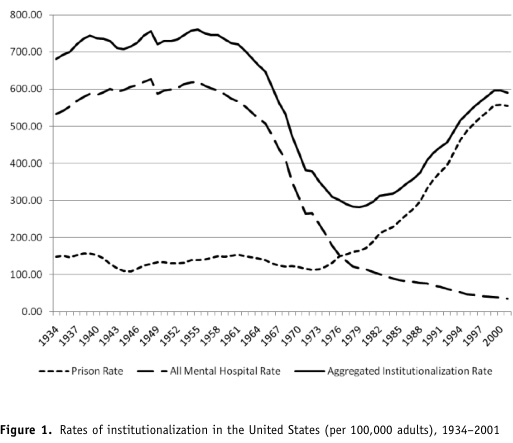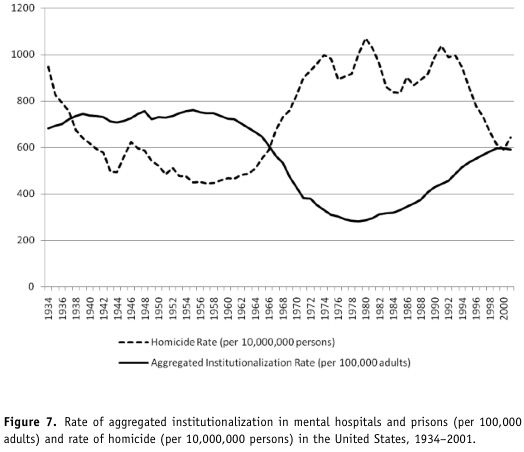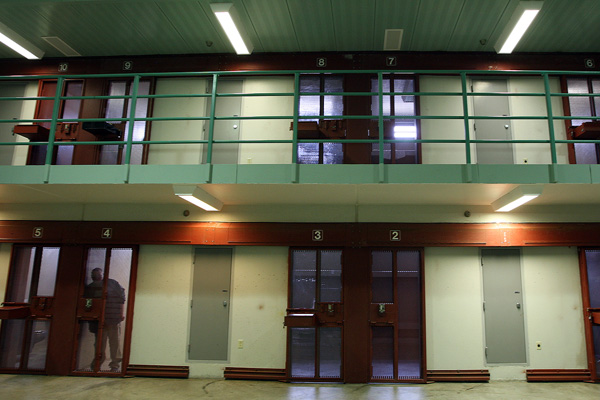The Economist is the latest publication to take a thwack at Chicago's crime problems. Fortunately, their take is pretty novel (via Andrew Papachristos). It's not about the homicide rate, but it does lead us back there in a roundabout fashion, through the story of Tracey Aldridge:
Thomas Dart, the sheriff of Cook County jail, knows Ms Aldridge [100 arrests since 1994] will end up back in his cells soon because there is nowhere else for her to go. She is sentenced, like so many seriously mentally ill people in America, to rotate in and out of correctional facilities until she dies. Prisons and jails are the main mental-health facilities in the country, something Sheriff Dart describes as an “abomination”. He is also angry about how fiscally reckless it is. At only 42, Ms Aldridge has already cost taxpayers $719,436 for her arrests and incarcerations.
The piece goes on to describe the county's efforts to find better alternatives than jail or prison for serial offenders like Aldridge, looking at the less promising ideas (like watching videos upon discharge) and more the more promising ones (like a secure home with ankle-bracelet monitoring). If these alternatives become reality, someone like Shermain Miles, after 396 arrests in 35 years, may finally get alternative treatment. In 2001, Grant Pick memorably described one such offender for the Reader:
Jeremy Unruh, an assistant state's attorney who has handled cases against Fly, calls the way vagrants like Fly continually move between the courts, jail, and the street "aggravated mopery." He thinks the problem exists because of a change in public policy in the 1970s that forced mental hospitals to release their less-impaired patients into the community. "The institutions had to release all borderline people," he says. "Kent would have been one of them. He doesn't really belong in jail, but he doesn't belong in the general public either."
The 1970s was when Shermain Miles started her endless string of arrests (it is not a surprise that she ended up in Uptown), and that's when the policy of deinstitutionalization really began to take hold. The Economist's piece very briefly touches on a fascinating paper by the University of Chicago's Bernard Harcourt that brings it full circle: the switch from mental institutionalization to prison and jail incarceration.
I grew up during the law-and-order '80s and '90s; I was eight when Willie Horton was used to torpedo Michael Dukakis. So America's massive prison industry has always been reality, making it difficult to imagine just how enormous the preceding mental-institution industry was. But it was really, really big.

America is rightfully in/famous for its incarceration rate, the highest in the world as of 2008. (European Union countries, by contrast, have higher mental hospital rates: a high of 188.5 in the Netherlands in 2000, compared to an EU average of 90.1, well above the U.S. rate.)
But only recently has the prison rate equalled the mental-institutionalization rate, and the combined rate is still lower. (If you include jails, the combined rate is slightly higher, as of 2001, than it was in the mid-20th century.)
And the low point where deinstitutionalization and the rise of the prison industry cross should look familiar if you're up on historical homicide rates in America.

The intuitive response is that the people who'd kill people were in mental wards, then they were out on the street, and now they're in jail or prison. But there's another facet, as Harcourt writes (emphasis mine):
This study identifies a previously unnoticed empirical relationship and cautiously speculates on the mechanism. The mechanism, it turns out, may be victimization rather than perpetration. Research has consistently shown that persons suffering from mental illness are far more likely to be victims of violent crime than the general population (Teplin et al. 2005; Teasdale 2009). Research has also identified a high correlation between being convicted of a crime and being a crime victim oneself (that is, outside prison): a substantial percentage of murder victims—one study indicates 44 percent overall and 51 percent of nonfamily murder victims (Dawson and Langan 1994, p. 1)—are individuals with a prior criminal history, and, vice versa, individuals in prison are at higher likelihood of being violent crime victims outside of prison (Karmen 2010, pp. 101–3). What may explain the results, then, is that the large institutionalized populations contain a higher proportion of potential homicide victims than the general population. The size of the institutionalized population may be relevant to homicide rates, not simply through perpetration, but through the higher victimization rates of the persons detained.
This is a pretty new line of inquiry, so it's still very much correlation and only hints at causation. Harcourt, in discussing his research at the legal blog The Volokh Conspiracy, cautions against using it to guide policy: "this study tells us nothing about the costs and trade-offs to society involved in imprisoning so many people, and whether the harm to the individuals affected by incarceration does not outweigh the harms to the victims of crime."
Nonetheless, it's an important piece of history: this isn't the first time America has had staggeringly high levels of its citizens confined to institutions, it's just taken a different form in the past three decades. And as Mike Konczal points out, incarceration is dropping again, as the financial crisis and the backlash against the War on Drugs work hand in hand to reduce the prison and jail population. If Harcourt's work isn't yet sufficient to drive policy, it does suggest critical lines of inquiry to be taken as the country deinstitutionalizes again.



